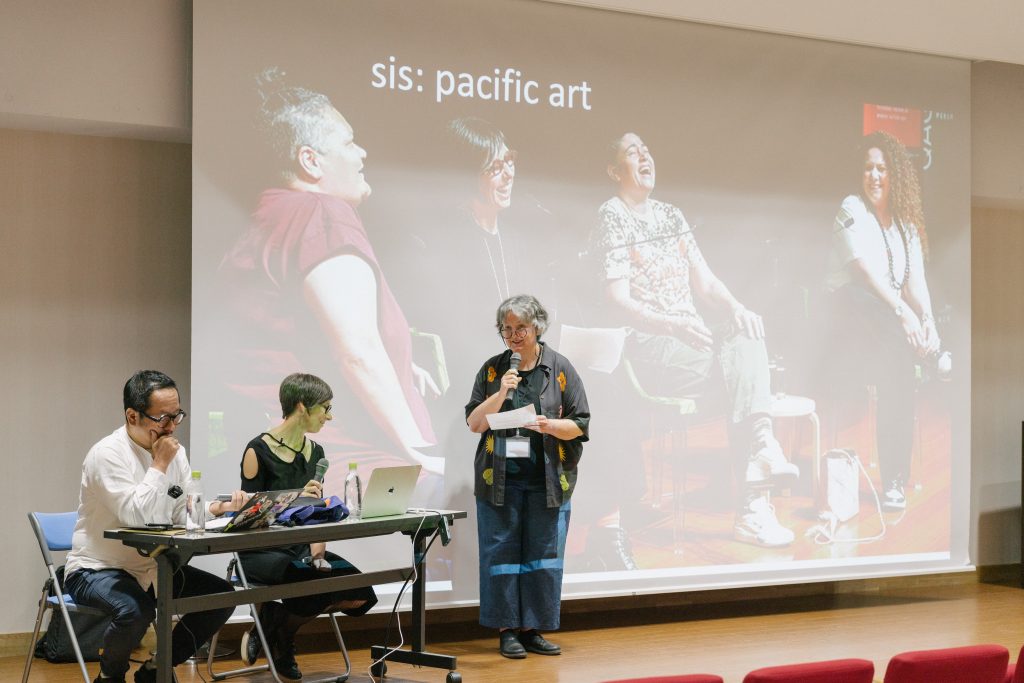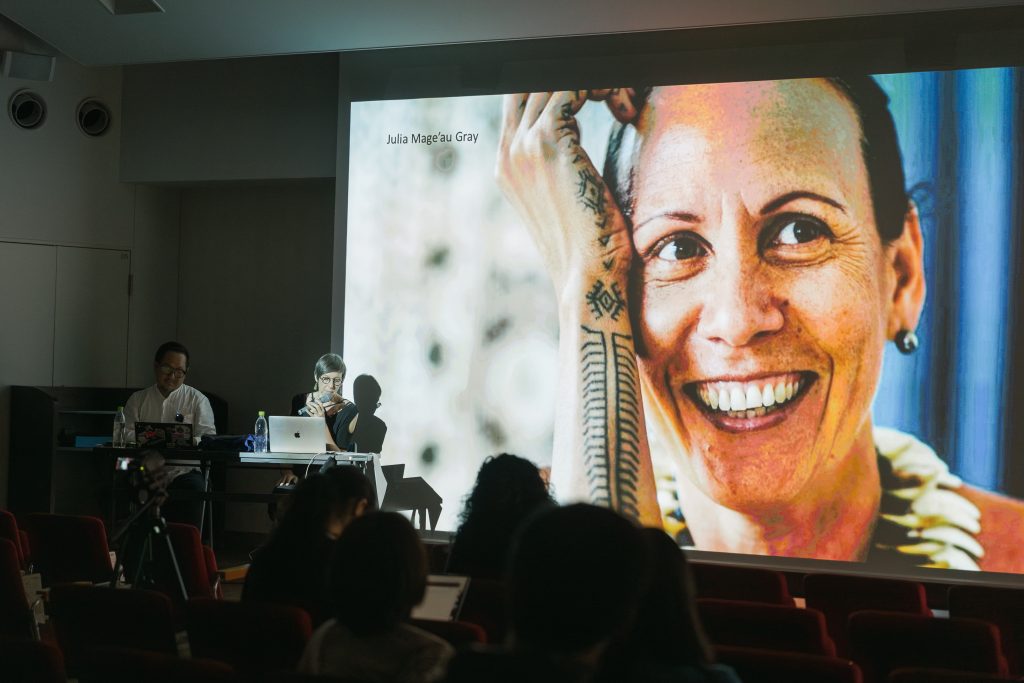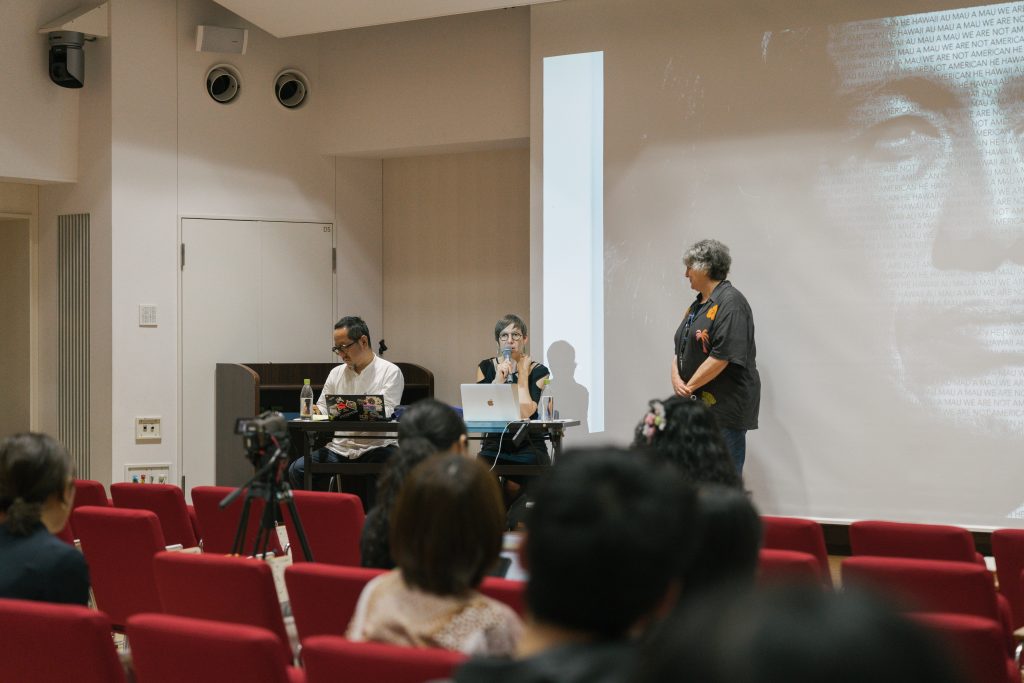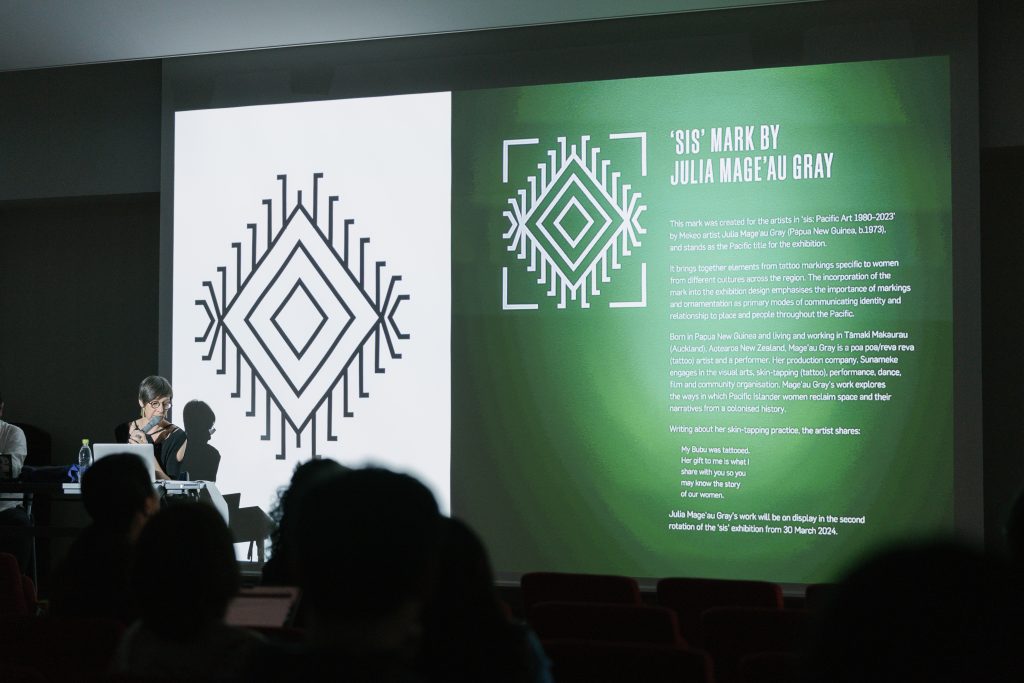ルース・マクドゥーガル氏「ヘイ、シス〜太平洋でのつながり作り」講演会レポート / Report on Ruth McDougall’s Open Lecture: “hey sis – creating connections in the Pacific “.
★Please scroll down for English text and link for bilingual video recording.
Speaker: ルース・マクドゥーガル (Ruth McDOUGALL)
クイーンズランド州立美術館 / 近代美術館、太平洋美術キュレーター (Curator, Pacific Art, Queensland Art Gallery / Gallery of Modern Art, Australia)

6月5日(水)、オーストラリア・ブリスベン市のクイーンズランド州立美術館 / 近代美術館(以下、QAGOMA)のキュレーター・ルース・マクドゥーガルさんが来日し、現在開催中のコレクション展「sis: Pacific Art 1980-2023」に関するレクチャーを行いました。
QAGOMAは、1993年から行われているアジア・オセアニア地域のアートを紹介するアジア・パシフィック・トリエンナーレ(APT)の拠点となる場所で、今年は第11回目が開催されます(2024年11月30日 – 2025年4月27日)。
「sis: Pacific Art 1980-2023」は、QAGOMAが収蔵する太平洋地域の現代美術の幅広いコレクションを紹介し、都市部ではなく、遠隔地、地方の州、島、珊瑚礁帯に住むアーティストを意識的に取りあげています。タイトルにある「sis」はSister(姉妹)を短縮した単語ですが、本展では「姉妹」と訳さず、女性とトランスジェンダーの「シスターズ」を意味します。シスターズたちが作り出す素晴らしい作品たちが中心に紹介されています。本展についてマクドゥーガル氏は「個人的でパーソナルなプロジェクトでした。QAGOMAに20年以上携わってきて、それの集大成としての展示だと思っています」と語ります。
マクドゥーガル氏は「sis: Pacific Art 1980-2023」展について以下のようにいいます。
昨今よくある「フェミニズム」にフォーカスした展示ではありません。「sis」は急進的に顕著にフェミニズムのメッセージがあるわけではないです。参加作家も自分達をフェミニストと称していません。とはいえ、太平洋地域においてジェンダーの問題がないわけではないです。
ただここに参加しているアーティストは自己決定権とか正義であったりとか、開放であったりとか、植民地支配的、または帝国主義的な暴力からの自由を求める戦いの方が、ジェンダーの問題より重要だと捉えています。
実際、アーティストの中には、母系的権威の目線から制作している人もいます。
本講演では、参加作家40人のうち、マクドゥーガル氏がピックアップした作家6名が紹介されました。本稿では特に気になった作家2名を取り上げてみます。
Julia Mageau Gray/ジュリア・マゴー・グレイ(パプアニューギニア、中央州、メケオ地区)

一人目に紹介されたアーティストJulia Mage’au Gray(ジュリア・マゴー・グレイ)は印象的でした。ダンサー、振付師、タトゥーアーティスト、写真家、映画製作者でもあるマゴー・グレイ氏は、パプアニューギニア人とメケオ人のバックグラウンドを持ちながら、都市や現代社会における課題に問いかけています。全身のタトゥーが彼女の特徴でもあります。
マクドゥーガル氏はマゴー・グレイ氏に彫ってもらったタトゥーを聴講者たちに見せました。マクドゥーガル氏は「これはあなたを守るための鍵だ」と彼女から言われて以来これをタトゥーとは思っていないと話します。彫った「印」が鍵となって守ってくれたということ。同時に自分が触れていいもの、触れてはいけないものを考えるきっかけとなっていると語りました。
また〈Best foot forward〉というマゴー・グレイ氏の映像作品も紹介されました。彼女の妹のヨラがメケオのスカートをまとって、赤いヒールを脱いで、ハイウェイを歩く作品です。本作のテーマは「道具」。ディアスポラな国オーストラリアで育ったパプアニューギニアの女性であるジュリア・マゴー・グレイとヨラが両国の文化から与えられた道具を使い、目的地に向かう作品は印象的でした。
Rosanna Raymond/ロザンナ・レイモンド(ニュージーランド)

Rosanna Raymond(ロザンナ・レイモンド)は、部屋に入って来るだけで自己紹介が終わるくらい存在感がある人だと言います。アーティストであり学者でもある彼女は芸術集団 Pacific Sisters(パシフィックシスターズ) のメンバーであり、SaVAge K’lub (サヴァージュ・クラブ)の創設者です。
パシフィックシスターズは、1992 年にオークランドで設立されたパフォーマーの集団です。都市における異文化や先住民、有色人種などの権利を主張したパフォーマンスは、1990年代衝撃を与えました。
2013年に立ち上がったサヴァージュ・クラブは、19世紀後半にロンドンで誕生した同名の紳士クラブから着想を得た作品です。SaVAgeのVA「ヴァー」はサモア語で「空間」を意味します。この空間は直線的な空間でもなければ空っぽの空間でもなく、人々によって活性化され、人と物の相互の関係をつくっていく「空間」です。
特に白人男性の目線で言う、肌の浅黒い乙女に対する美しさ、セクシュアリティの概念のイメージを覆すことを目的とし、本作は女性やそのセクシュアリティに対する偏見に一石を投じたものでした。

講演会を聴いて、まず、自身が太平洋諸島諸国についての知識がないことに気付かされました。太平洋地域における社会問題や争いに気がつけていないこと、こんなにも多才で素晴らしいアーティスト達の活動や表現があることに衝撃を受けました。
改めて考えてみますと、我々が追っているのは無論欧米のアートシーンです。今後の日本の美術館が存続していくためには、こうした様々な地域の芸術活動に光をあてていくことが必要であり、新しい価値と歴史をつくっていく基盤となるでしょう。
また、マクドゥーガル氏が「参加しているアーティストは自己決定権とか正義であったりとか、開放であったりとか、植民地支配的、または帝国主義的な暴力からの自由を求める戦いの方が、ジェンダーの問題より重要だと捉えています。」「アーティストの中には、母系的権威の目線から制作している人もいます。」と言うように、ジェンダーの価値観や捉え方が、その人の住んでいる社会や文化によって異なることも改めて気付かされました。
最後の質問コーナーでは、筆者もマクドゥーガル氏へ質問をしました。
地域の原住民や植民地の歴史がある時は、その歴史を考慮して、作家と作品を展示したりすると思うのですが、どのようにしてキュレーションされていますか?場所のリサーチ、現地の人々とのコミュニケーションはどのようにしていますか?
アーティストとか作品とか、なんかこう煌めきみたいなものがあります。それは、どこかすごい遠い場所で、女性が一人で子ども5人を育てて、子どもが走り回っている中、染め物をしていたりするわけですよね。オークランドのどこかの綺麗なスタジオで作家が一人で淡々と制作しているのは全然違うことなんだけど、見たときに、「あ、これは見せたい」自分の展示に持っていきたいみたいなそういう煌めき、輝きがまずあります。
私たちがリサーチに行く先は、ほぼギャラリーなど無く、パプアニューギニアにあるのは民族博物館くらいです。民族博物館に行ったりとか、地元の市場、既に一緒に仕事をしている地元のアーティスト、文化人類学やアカデミックな研究者などの人たちに聞いたりします。だけど、やはり関係性が必要なのです。購入して展示して終わりではなく、出会ったら、その関係性を紡いでいかないと特に太平洋地域はまわっていきません。
常に同じ作家を使うとかではなく、ポイント、ポイントで、出会った人たちのコミュニティや出会ったアーティストと工芸をやっている人たちのところに「こんにちは」っていう対話を続ける、紡いでいった結果としての関係性、その関係性の上でしか成り立たないと思います。
女性の美術大学と聞いて、率直にどのような印象をお持ちになりますか?
女子だけの大学。それは最高だと思います。できれば私もそういったところを卒業したかったです。

一般的にキュレーターの仕事は、既存の美術史にある美術作品を研究し保護しながら展示をしたり、コレクションを形成したりすることですが、マクドゥーガル氏のキュレーターの仕事は一般的なそれとは少し異なるものでした。氏がアーティストと出会うエリアには画廊や美術館はなく、都市部のようなアートシーンはありません。そのようなエリアでは現地の人々とのコミュニケーションと信頼関係の構築が必要不可欠です。敬意を持って信頼関係を結び、時には精神的に家族となったりして、人々と物語を紡いでいかなくてはなりません。
こうした繋がりの先に素晴らしい芸術や表現と出会いがあるのだと思いました。このような活動が現在の日本のキュレーションにおいて、いかに大切なことであるか我々はマクドゥーガル氏そしてQAGOMAから学ばなくてはならないのです。
オープン・レクチャー(杉並キャンパス)
日時:2024年6月5日(水) 16:40~18:10 *英日逐次通訳付き
講演会:ヘイ、シス 〜 太平洋でのつながり作り
場所:女子美術大学 杉並キャンパス7号館7201教室
女子美術大学 外国招聘特別講師による講演会
共催:女子美術大学 教養・共通専門研究室、国際センター
後援:オーストラリア大使館
企画:リンダ・デニス教授
Report on Ruth McDougall’s “Open Lecture: hey sis – creating connections in the Pacific “.
Speaker: Ruth McDOUGALL
Curator, Pacific Art, Queensland Art Gallery / Gallery of Modern Art, Australia

On 5 June (Wed), Ruth McDougall, Curator of the Queensland Art Gallery / Museum of Modern Art (QAGOMA), Brisbane, Australia, visited Japan to give a lecture on the current collection exhibition “sis: Pacific Art 1980-2023” held at QAGOMA.
QAGOMA is the home of the Asia Pacific Triennial of Contemporary Art (APT), which has been taking place since 1993 to showcase art from the Asia-Oceania region and will host its 11th edition this year (30 Nov 2024 – 27 Apr 2025).
“sis: Pacific Art 1980-2023” showcases QAGOMA’s extensive collection of contemporary art from the Pacific, consciously featuring artists from remote, rural states, islands and coral reef zones rather than urban areas. The word ‘sis’ in the title is a shortened form of the word Sister, but in this exhibition, it does not refer to only ‘sisters’, but is used more broadly to include female and transgender ‘sisters’. The exhibition focuses on the wonderful artworks created by a sisterhood of artists. Of the exhibition, McDougall says: “It was a personal and individual project – I’ve been involved with QAGOMA for over 20 years, and I see it as the culmination of that.”
McDougall says of the exhibition “sis: Pacific Art 1980-2023”.
It is not a ‘feminist’ focused exhibition, as is often the case these days. sis does not have a radical, pronounced feminist message. The participating artists do not refer to themselves as feminists either. Nevertheless, this does not mean that gender issues are not present in the Pacific region.
However, the artists participating here see the right to self-determination, justice, liberation and the fight for freedom from colonial or imperialist violence as more important than gender issues.
Indeed, some of the artists work from the perspective of matriarchal authority.
In this lecture, six of the 40 participating artists were introduced, picked out by McDougall. This paper will focus on two of the artists who were of particular interest.
Julia Mageau Gray(Mekeo District, Central Province, Papua New Guinea)

The first artist introduced, Julia Mageau Gray, was particularly impressive. A dancer, choreographer, tattoo artist, photographer and filmmaker, Julia Mageau Gray ‘s Papua New Guinean and Mekeo background led her to question issues in urban and contemporary society. Tattoos all over her body are her signature.
McDougall showed the audience her tattoos, which were carved by Julia Mageau Gray. McDougall said that she told her, “This is a key to protect you” and that she has not thought of it as a tattoo ever since. It means that the ‘mark’ that I had tattooed on me was a key to protect me. At the same time, she said, it has made her think about what she is allowed to touch and what she is not allowed to touch.
She also introduced a video work by Julia Mageau Gray, called “Best foot forward”. In this film, her sister Yola walks down a highway in a Mekeo skirt, taking off her red high heels. The theme of this film is ‘tools’. The work was impressive as Julia Mageau Gray, and Yola, a Papua New Guinean woman who grew up in the diaspora country of Australia, use tools given to them by both cultures to get to their destination.
Rosanna Raymond (Aotearoa New Zealand)

It is said that Rosanna Raymond has such a presence that she can walk into a room without any need of extra introduction. An artist and scholar, she is a member of the arts collective Pacific Sisters and founder of the SaVAge K’lub.
Pacific Sisters is a collective of performers founded in Auckland in 1992. Their performances, which advocated for the rights of different cultures, indigenous peoples and people of colour in the city, had an impact in the 1990s.
Launched in 2013, the SaVAge Club was inspired by the gentleman’s club of the same name that emerged in London in the late 19th century; the VA ‘va’ in SaVAge means ‘space’ in Samoan. This space is not a linear or empty space, but a ‘space’ that is activated by people and creates mutual relationships between people and objects.
Aiming to overturn the image of beauty and notions of sexuality towards dark-skinned maidens, especially from the perspective of white men, this work targeted prejudice against women and their sexuality.

Listening to the lecture, I was first struck by my lack of knowledge about the Pacific Island countries. I was shocked that I was not aware of the social problems and conflicts in the Pacific region and that there are so many versatile and wonderful artists working and expressing themselves in the region.
Thinking about it again, it is of course due to the fact we mainly follow the European and American art scenes. For Japanese museums to survive in the future, it is necessary to shine a light on a wider range of more local artistic activities such as presented in this lecture, which will provide the basis for creating new values and history.
Also, as McDougall says, “the artists participating here see the right to self-determination, justice, liberation and the fight for freedom from colonial or imperialist violence as more important than gender issues “, “Indeed, some of the artists work from the perspective of matriarchal authority.”As she said, we were also reminded that gender values and perceptions differ depending on the society and culture in which a person lives.
The author asked questions to McDougall during the question-and-answer session at the end of the lecture.
When there is a local indigenous or colonial history, how do you curate your exhibitions with the artists and their works, taking that history into account? How do you research the location and communicate with the local people?
There is something like a glimmer in an artist or a work of art. It’s a woman somewhere very far away, raising five kids by herself, doing dyeing while kids run around her. It’s a completely different thing to have an artist working alone in a beautiful studio somewhere in Auckland, but when you see it, there’s that kind of glimmer, that sparkle that makes you say, ‘Oh, I want to show this,’ and you want to bring it to your own exhibition.
Where we go to do our research, there are almost no galleries, and the only one in Papua New Guinea is the Ethnographic Museum. We go to ethnographic museums, local markets, visit local artists we already work with, cultural anthropologists and academics, and so on. But you still need a relationship. It is not the end of the process when buying and exhibiting. Once you meet, you need to weave that relationship, especially in the Pacific region.
It’s not about using the same artists all the time, it’s about continuing the dialogue, saying ‘hello’ to the communities of the people you meet, the artists you meet and the people doing crafts, and the relationships that are the result of that spinning, and I think it can only happen based on those relationships.
What is your impression of a women’s art university, frankly?
A university for women only. I think that’s the best. I would have liked to graduate from such a place if I could.

Typically, a curator’s job is to research and protect existing works of art history while exhibiting them and forming collections, but McDougall’s curatorial work was a little different from the norm. In the areas where she meets artists, there are no art galleries or museums, and there is no urban art scene. In such areas it is essential to communicate and build trust with the local people. We must weave a story with the people, respectfully building a relationship of trust and sometimes even becoming a family in spirit.
It was at the end of these connections that I found wonderful art and expression and encounters. We must learn from McDougall and QAGOMA how important such activities are in curation in Japan today.
Open Lecture (Suginami Campus)
International Special Lecturer Program, Joshibi University of Art and Design
Date: Wed 5 June 2024, 4:40pm – 6:10pm *English-Japanese interpretation provided
Lecture: hey sis – creating connections in the Pacific
Place: Room 7201 (2nd floor of Building 7), Suginami Campus, Joshibi University of Art and Design
Co-organization: Liberal Arts and Interdisciplinary Education Unit, Center for International Relations, Joshibi University of Art and Design
Official Support: Australian Embassy Tokyo
Planning: Prof. Linda DENNIS
★女子美術大学_国際センターYouTube Channel:@JOSHIBI_INTERNATIONAL
講演会記録動画リンク/Link for bilingual video recording:https://youtu.be/ORg9A1m7gEc?si=RodngN80vTd3O5
執筆者 Writer: 田中直子 Naoko Tanaka

女子美クリエイティブ・ラボラトリー助手。東京藝術大学大学院国際芸術創造研究科アートプロデュース専攻博士後期課程修了(2023年度)。女子美術大学アートプロデュース表現領域にて修士と学士。1938年に行われた児童画コンクール「日独伊親善図画」の研究をしながら、展覧会のキュレーションや執筆活動なども行っている。
Tanaka has a Ph.D. in Graduate School of Global Arts, Tokyo University of the Arts. Research associate in Joshibi University Creative Lab. She has been conducting research on the children drawings submitted to “Japan–Germany–Italy Goodwill Drawings (1938)” and has also curated several exhibitions on the subject.








